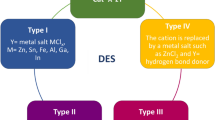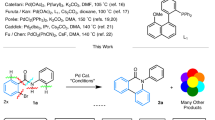Abstract
The degree of enzyme deactivation for lipases from Candida rugosa and Pseudomonas sp., hydroxynitrile lyase and mandelate racemase upon exposure to organic solvents can be correlated to their respective partition coefficients (log P values). However, three unexpected results were obtained: (1) the deactivation exerted by protic solvents, e.g., methanol, is severely underestimated; (2) little deactivation by an organic solvent cannot neccessarily be correlated to catalytic activity in this medium, and (3) in contrast to other enzymes, hydroxynitrile lyase is exceptionally stable towards deactivation by DMF.
Similar content being viewed by others
References
Adlercreutz P, Mattiasson B (1987) Aspects of biocatalyst stability in organic solvents. Biocatalysis 1: 99-108.
Andersson M, Holmberg H, Adlercreutz P (1998) Prediction of the remaining activity of horse liver alcohol dehydrogenase after exposure to various organic solvents. Biocatal. Biotransfor. 16: 259-273.
Bauer C, Boy M, Faber K, Felfer U, Voss H (2001) Activation of mandelate racemase via immobilisation in lyotropic liquid crystals for biocatalysis in organic solvents: application and modelling. J. Mol. Catal. B 16: 91-100.
Carrea G, Riva S (2000) Properties and synthetic applications of enzymes in organic solvents. Angew. Chem., Intern. Ed. 39: 2226-2254.
Colton IJ, Ahmed SN, Kazlauskas RJ (1995) A 2-propanol treatment increases the enantioselectivity of Candida rugosa lipase towards esters of chiral carboxylic acids. J. Org. Chem. 60: 212-217.
Faber K, Ottolina G, Riva S (1993) Selectivity enhancement of hydrolase reactions. Biocatalysis 8: 91-132.
Fitzpatrick PA, Klibanov AM (1991) How can the solvent affect enzyme enantioselectivity? J. Am. Chem. Soc. 113: 3166-3171.
Gruber K, Gugganig M, Wagner UG, Kratky C (1999) Atomic resolution crystal structure of hydroxynitrile lyase from Hevea brasiliensis. Biol. Chem. 380: 993-1000.
Halling PJ (1994) Thermodynamic predictions for biocatalysis in nonconventional media: theory, tests, and recommendations for experimental design and analysis. Enzyme Microb. Technol. 16: 178-206.
Hasslacher M, Schall M, Hayn M, Griengl H, Kohlwein SD, Schwab H (1996) Molecular cloning of the full-length cDNA of (S)-hydroxynitrile lyase from Hevea brasiliensis. J. Biol. Chem. 271: 5884-5891.
Laane C, Boeren S, Vos K, Veeger C (1987) Rules for optimization of biocatalysts in organic solvents. Biotechnol. Bioeng. 30: 81-87.
Stecher H, Felfer U, Faber K (1997) Large-scale production of mandelate racemase by Pseudomonas putida ATCC 12633: optimization of enzyme induction and development of a stable crude enzyme preparation. J. Biotechnol. 56: 33-40.
Stecher H, Hermetter A, Faber K (1998) Mandelate racemase assayed by polarimetry. Biotechnol. Tech. 12: 257-261.
Weber HK, Stecher H, Faber K (1999) Some properties of commercially available crude lipase preparations. In: Roberts SM, ed. Biocatalysts for Fine Chemicals Synthesis. Chichester: Wiley, module 5:2.1.
Author information
Authors and Affiliations
Rights and permissions
About this article
Cite this article
Pogorevc, M., Stecher, H. & Faber, K. A caveat for the use of log P values for the assessment of the biocompatibility of organic solvents. Biotechnology Letters 24, 857–860 (2002). https://doi.org/10.1023/A:1015598523282
Issue Date:
DOI: https://doi.org/10.1023/A:1015598523282




